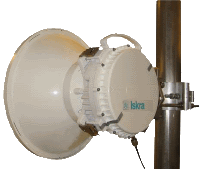
 The equipment SparkWave series has different outdoor and indoor radio relay units. SparkWave SDR indoor unit is modular. Different housings and high integration level allow easy interconnection, stacking with ESSI interface and direct connection to existent F/O networks. Outdoor units (ODU) is connected to the IDU via single coaxial cable up to 400 m. The outdoor units are connected to antennas using waveguide up to 1.8 m.
The equipment SparkWave series has different outdoor and indoor radio relay units. SparkWave SDR indoor unit is modular. Different housings and high integration level allow easy interconnection, stacking with ESSI interface and direct connection to existent F/O networks. Outdoor units (ODU) is connected to the IDU via single coaxial cable up to 400 m. The outdoor units are connected to antennas using waveguide up to 1.8 m.
- backbone networks for packet / TDM service providers;
- cellular / CDMA / LTE / WiMAX backhaul networks;
- fixed wireless networks;
- enterprise/corporate campus/business park LAN extension;
- replace carrier leased lines, eliminate expensive recurring costs;
- wireless IP / Ethernet Video Streaming / Surveillance;
- access networks for Enterprises;
- multi-service private wireless networks for energy, traffic, utilities operators;
Features:
- split-mount or optional all-indoor architecture;
- modulation hitless adaptive or fixed up to QAM1024;
- bandwidth up to 80 MHz;
- bitrate up to 900Mb/s (2+0@56 MHZ channel);
- SFP for GE interface optical/electrical;
- up to 4x16E1 interfaces using external 16E1 box;
- indoor unit 1U high and ? U width;
- WEB based EMS.
| Modulation |
QPSK, 16QAM, 32QAM, 64QAM, 128QAM, 256QAM, 512QAM, 1024QAM |
| Number of IF channels | 2 channels, Dual-channel modem |
| Channel BW - ETSI |
14 / 28 / 40 / 56 / 80 MHz |
| IF Connector |
N-type female 2X |
| TX power 5-8 GHz/QPSK |
30 - 21 dBm |
| TX power 13-18 GHz/QPSK-1024 | 26 - 16 dBm |
| TX power 23-26 GHz/QPSK-1024 | 25 - 15 dBm |
| TX power 32-38 GHz/QPSK-1024 | 23 - 13 dBm |
| Compression function | Online Ethernet L1 header compression |
| Max. Real Data Throughput | up to 1.374 Gbps in 2+0 mode at 80 MHz channel |
| Co-channel transmission | XPIC supported for dual-polarization transmission |
| Security | AES-128/256 Encryption |
| Number of Eth ports | 3 x Gigabit Ethernet (RJ-45) |
| 4x SFP (1000BASE-SX/LX) | |
| Maximum Frame Size | up to 2048/10240 bytes |
| VLAN | up to 4096 VLANs |
| QoS | Source Port, 802.1p, IPv4 TOS/DSCP, IPv6 TC, VLAN VID, SA/DA |
| PTP 1588 | (FLP) fixed latency PTP 158 |
| MAC table | up to 8192 addresse |
| Main NMS ports | ETH port LAN |
| Additional NMS ports | serial interface over USB-B (alternative IP port) |
| Protocols – Network | HTTP, HTTPS, SNMP v.1/v.2c/v.3, TELNET, SSH |
| Operational temperature range ODU | -35°C to + 55°C |
| Operational temperature range IDU | -5°C to + 50°C |
| Power consumption IDU and ODU | 55 W max. |
| Weight IDU | 3,9 kg |
| Weight ODU | 2,2 kg |
| Dimension [w x h x d] IDU | ?330 mm х 95 mm |
| Dimension ODU | 220 mm х 44 mm х 240 mm |

